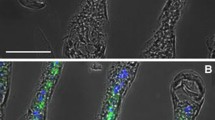Abstract
Purified membrane-bound Na+−K+-ATPase from rat kidney outer medulla was studied by freeze-fracturing, by freeze-etching and by negative staining. Freeze-fracturing of purified Na+−K+-ATPase membranes shows intramembraneous particles with a diameter of about 100 Å. The frequency of these intramembraneous particles — as estimated from the particle densities on the two fracture faces — lies between 4700 and 5600 particles per μm2. Applying rotary shadowing a four partite substructure could be detected in these intramembraneous particles observed on the fracture planes. The same four partite substructure was detected in particles observed on freeze-fractured and rotary shadowed intact baso-lateral plasma membranes of the thick ascending limb of Henle's loop. Particles could be also detected on both membrane surfaces of the purified Na+−K+-ATPase. These surface particles have about the same diameter and are present at about the same frequency as those observed within the freeze-fractured membranes. Negative staining of isolated Na+−K+-ATPase membranes showed particles on both membrane surfaces with a diameter between 30 and 50 Å, at a frequency of about 19,000 per μm2. On aspects of membrane edges we observed structures which suggest a transmembraneous connection of the negatively stained particles on both membrane surfaces.
Our results suggest that the Na+−K+-ATPase protein is composed of four units and that each unit spans the cell membrane. The native enzyme structure of the Na+−K+-ATPase protein seems to be preserved during freeze-fracturing and freeze-etching. It is proposed that the four enzyme units of the Na+−K+-ATPase complex are dissociated during the negative staining procedure.
Similar content being viewed by others
References
Clarke, S.: The size and detergent binding of membrane proteins. J. Biol. Chem.250, 5459–5469 (1975)
Deguchi, N., Jørgensen, P. L., Maunsbach, A. B.: Ultrastructure of the sodium pump. Comparison of thin sectioning, negative staining, and freeze-fracture of purified, membrane-bound (Na+, K+)-ATPase. J. Cell Biol.75, 619–634 (1977)
Fricke, U., Klaus, W.: Evidence for two different Na+-dependent3H-ouabain binding sites of a Na+−K+-ATPase of guinea-pig hearts. Br. J. Pharmacol.61, 423–428 (1977)
Gache, C., Rossi, B., Ladzunski, M.: (Na+−K+)-activated adenosinetriphosphatase of axonal membranes, cooperativity and control. Steady-state analysis. Eur. J. Biochem.65, 293–306 (1976)
Glitsch, S.: Verdampfung von Platin aus Kohletiegeln zur elektronenmikroskopischen Schrägbedampfung. Naturwissenschaften56, 559 (1969)
Haase, W., Koepsell, H.: Electron microscopy of membrane-bound (Na+−K+)-ATPase protein. Pflügers Arch.379, R31 (1979)
Hansen, O.: Non-uniform populations of g-strophanthin binding sites of (Na+−K+)-activated ATPase. Apparent conversion to uniformity by K+. Biochim. Biophys. Acta433, 383–392 (1976)
Ikemoto, N., Sreter, F. A., Nakamura, A., Gergely, J.: Tryptic digestion and localization of calcium uptake and ATPase activity in fragments of sarcoplasmic reticulum. J. Ultrastruct. Res.23, 216–232 (1968)
Inesi, G., Asai, H.: Trypsin digestion of fragmented sarcoplasmic reticulum. Arch. Biochem. Biophys.126, 469–477 (1968)
Jørgensen, P. L.: Purification and characterization of (Na++K−)-ATPase. III. Purification from the outer medulla of a mammalian kidney after selective removal of membrane components by sodium dodecylsulfate. Biochim. Biophys. Acta356, 36–52 (1974)
Jørgensen, P. L.: Purification and characterization of (Na++K+)-ATPase. IV. Estimation of the purity and of the molecular weight and polypeptide content per enzyme unit in preparations from the outer medulla of rabbit kidney. Biochim. Biophys. Acta356, 53–67 (1974)
Kepner, G. R., Macey, R. I.: Membrane enzyme systems. Molecular size determinations by radiation inactivation. Biochim. Biophys. Acta163, 188–203 (1968)
Koepsell, H.: Characteristics of antibody inhibition of rat kidney Na+−K+-ATPase. J. Membr. Biol.44, 85–102 (1978)
Kyte, J.: The titration of the cardiac glycoside binding site of the (Na++K+)-adenosine triphosphatase. J. Biol. Chem.247, 7634–7641 (1972)
Kyte, J.: Properties of two polypetides of sodium- and potassium-dependent adenosine triphosphatase. J. Biol. Chem.247, 7642–7649 (1972)
Kyte, J.: Structural studies of sodium and potassium ion-activated adenosine triphosphatase. The relationship between molecular structure and the mechanism of active transport. J. Biol. Chem.250, 7443–7449 (1975)
Margaritis, L. H., Elgsaeter, A., Branton, D.: Rotary replication for freeze-etching. J. Cell Biol.72, 47–56 (1977)
Martonosi, A.: Sarcoplasmic reticulum. V. The structure of sarcoplasmic reticulum membranes. Biochim. Biophys. Acta150, 694–704 (1968)
Maunsbach, A. B., Jørgensen, P. L.: Ultrastructure of highly purified preparations of (Na++K+)-ATPase from the outer medulla of rabbit kidney. Eighth Internat. Congress on Electron Microscopy, Canberra, Vol. II, pp. 214–215 (1974)
Medzihradsky, F., Kline, M. H., Hokin, L. E.: Studies on the characterization of the sodium-potassium transport adenosine triphosphatase. I. Solubilization, stabilization, and estimation of apparent molecular weight. Arch. Biochem. Biophys.121, 311–316 (1967)
Nakao, M., Nagano, K., Nakao, T., Mizuno, N., Tashima, Y., Fujita, M., Maeda, H., Matsudaira, H.: Molecular weight of Na,K-ATPase approximated by the radiation inactivation method. Biochem. Biophys. Res. Commun.29, 588–592 (1967)
Schoner, W., Pauls, H., Patzelt-Wenczler, R.: Biochemical characteristics of the sodium pump: Indications for a half-of-the-sites reactivity of the (Na++K+)-ATPase. In: Myocardial failure (G. Riecker, A. Weber and J. Goodwin, eds.), p. 104. Berlin, Heidelberg, New York: Springer 1977
Stewart, P. S., MacLennan, D. H.: Surface particles of sarcoplasmic reticulum membranes. Structural features of the adenosine triphosphatase. J. Biol. Chem.249, 985–993 (1974)
Vogel, F., Meyer, W. M., Grosse, R., Repke, K. R. H.: Electron microscopic visualization of the arrangement of the two protein components of (Na++K+)-ATPase. Biochim. Biophys. Acta470, 497–502 (1977)
Yu, J., Branton, D.: Reconstitution of intramembrane particles in recombinants of erythrocyte protein band 3 and lipid: Effects of spectrin-actin association. Proc. Natl. Acad. Sci. U.S.A.73, 3891–3895 (1976)
Author information
Authors and Affiliations
Rights and permissions
About this article
Cite this article
Haase, W., Koepsell, H. Substructure of membrane-bound Na+−K+-ATPase protein. Pflugers Arch. 381, 127–135 (1979). https://doi.org/10.1007/BF00582343
Received:
Issue Date:
DOI: https://doi.org/10.1007/BF00582343




